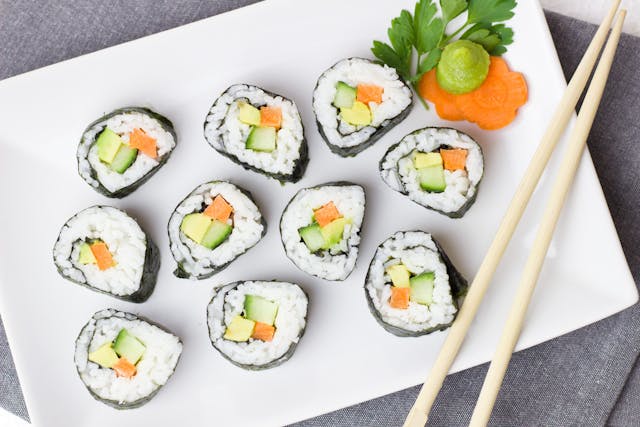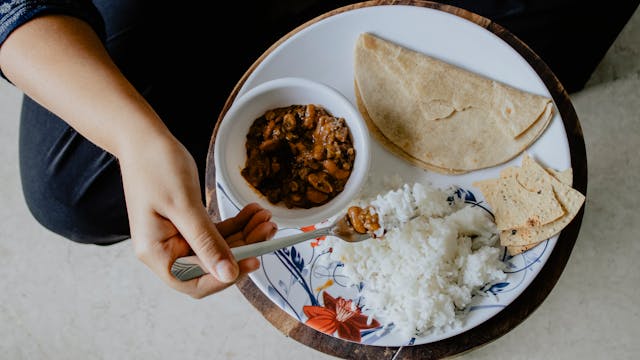There is a debate in the culinary world on which rice is healthier between sushi rice vs white rice. White rice is a very popular food, but can it be used to prepare a traditional Japanese sushi recipe.
The traditional sushi recipe is unique to Japanese culture. Preparing sushi is not as common as cooking white rice. Chefs serving traditional Japanese sushi at restaurants use shorter-grain rice, which is different from normal white rice.
Sushi rice has a different texture and the flavour of the meal is also different from that of white rice.
Planning on making your sushi or giving it a try, stay with us as we discuss the difference between sushi rice and white rice.

What Is Sushi Rice?
Sushi rice is a different type of rice with shorter grains of rice. Sushi rice is soft and sticky and it’s the best grain to prepare the traditional Japanese sushi.
The texture of sushi rice is different from that of white or any other rice. The grains have a translucent and stickier appearance.
The best way to prepare sushi rice is by streaming and adding vinegar. When cooked, the rice appears different from other rice. Adding vinegar and streaming the grain to a fine form makes it fluffy and sticky.
Other ingredients are added to the grain to make it tasty. The rice is allowed to cool before it’s moulded into balls, which is the sushi rice.
Also Read: Vegan vs Vegetarianism: Difference and Comparison

White Rice
White rice is a different kind of rice from the sushi rice. It’s a milled rice that has undergone the removal of its bran, germ, and husk. Removing the bran, germs, and husk alters the flavour, appearance, and texture of the rice.
The removal process prevents spoilage, extending the grain’s storage life and making it easier to digest when consumed.
Once the rice is milled, it’s then polished to give a bright, white and shiny appearance. White rice loses nutrients during the milling and polishing processes.
Despite this, white rice remains one of the most widely eaten foods in the world.
Sushi Rice vs White Rice: Key Difference between Sushi Rice and White Rice
Sushi rice is a different kind of rice, with a shorter grain. Sushi rice is stickier and softer and it’s the main ingredient in the traditional Japanese cuisine sushi.
The sticky texture of sushi rice makes it the perfect grain for moulding into shapes. Sushi rice is seasoned with a mixture of vinegar, salt, and sugar, giving it a unique flavour and taste. These ingredients give a flavour that complements other sushi components.
White rice is a milled rice that loses some of its nutrients in the refining process. White rice can range from long-grain to short-grain varieties.
The major difference between sushi rice and white rice is the texture. White rice also comes in shorter grains like sushi rice, but sushi rice is stickier in texture than white rice.
The texture of the sushi rice makes it ideal for the traditional Japanese cuisine. The best way to prepare the meal is to allow the sushi rice to cool after cooking. The sushi rice is then moulded into balls with the ingredients mixed to give a unique flavour.
White rice is known for its fluffier texture and its grains are more distant- which makes it suitable as a side dish. White rice can be parboiled before it’s properly cooked. Some people prefer to wash with warm water before cooking.
Preparing sushi rice requires carefulness. The sushi rice should be washed carefully and then soaked before cooking. While the rice is still warm, it’s seasoned to get the best flavour out of it.
This preparation method is important if you want to the sushi rice to have the best texture and taste.
Preparing white rice mainly involves rinsing, boiling, and steaming. White rice can be served plain with stew or porridge or as part of other culinary creations.
Also Read: Veganism vs Vegetarianism: Difference and Comparison
Sushi Rice vs White Rice: Is Sushi Rice Healthier than White Rice?
If you look at the physique of the average Japanese person, you would be convinced that they maintain a healthy diet. So, does that make sushi a healthy food?
Sushi rice is a traditional Japanese cuisine that may not be as healthy as most people think. Sushi rice has a stickier and softer texture, making it the perfect grain for sushi.
However, sushi rice is not healthier than white rice as both grains have the same health benefits. If you are looking for a healthier rice, your best option is the brown rice.
Yes, the brown rice is healthier than both the sushi rice and the white rice. Both the sushi rice and the white rice contain a good amount of starch. Consuming starchy food is not supportive of weight loss.
Sushi Rice vs White Rice: Can White Rice be used for Sushi?
Well, you can substitute white rice for sushi rice if you cannot find sushi rice to make your dish. But expect the texture of the sushi balls to be different.
The texture of white rice is not sticky to hold the sushi balls firmly together. It may serve the purpose of making sushi, but it won’t be sticky compared to when sushi rice is used.
Sushi Rice vs White Rice: Can I Use Sushi Rice as Normal Rice?
You can use sushi rice as normal rice to prepare a meal. Results will be great if you only follow certain methods.
Make sure you wash the sushi rice in cold water. You may also want to steam the rice to prevent it from getting stickier than normal rice.
Also Read: Turnip vs Radish: Difference and Comparison
Sushi Rice vs White Rice: Comparison Chart
| Sushi Rice | White Rice | |
| Grain type | Short-grain and sticky | Varies, often long-grain and fluffy |
| Texture | Sticky and firmly holds shapes | Fluffy, grains separate easily |
| Seasoned | Vinegar, sugar, and salt | Only served plain |
| Culinary use | Primarily for sushi | Used in a variety of dishes |
| Preparation | Washed, soaked, and seasoned | Rinsed, boiled, or steamed |
Sushi Rice vs White Rice: Nutritional Content in Sushi Rice and White Rice
The table below shows the calorie content of 100 grams of serving sushi rice and white rice according to the FDC search results.
| Nutrients | Sushi Rice | White Rice |
| Carbohydrates | 18.4g | 14.8g |
| Protein | 2.92g | 1.42g |
| Fat | 0.67g | 0.15g |
| Calcium | 0.9mg | 5mg |
| Cholesterol | 4mg | 0mg |
| Dietary fibres | 1g | 0.2g |
| Sodium | 428mg | 1mg |
Frequently Asked Questions
Below are frequently asked questions about the difference between sushi rice and white rice.
Is sushi rice healthy for weight loss?
A well-served traditional Japanese sushi dish contains low fats and calories. Sushi can be prepared with the lowest ingredients and you don’t have to fry it in oil and mayonnaise.
Is white rice similar to sushi rice?
Sushi rice and white rice are two different kinds of rice, with the latter having a shorter grain, stickier, and softer. White rice is less translucent and it’s long to medium in size compared to the sushi rice.
Also Read: Burrito vs Kebab: Difference and Comparison
Is Japanese sushi rice healthy?
Sushi rice is a traditional Japanese cuisine that may not be as healthy as most people think. Sushi rice has a stickier and softer texture, making it the perfect grain for sushi.
Compared to white rice, sushi rice has a higher nutritional content.
Can I use white rice for sushi?
Well, you can substitute white rice for sushi rice if you cannot find sushi rice to make your dish. But expect the texture of the sushi balls to be different.
The texture of white rice is not sticky to hold the sushi balls firmly together. It may serve the purpose of making sushi, but it won’t be sticky compared to when sushi rice is used.
Conclusion
Sushi rice and white rice are two different grains, with the sushi ice having a sticker and softer texture than normal rice. Sushi rice is prepared by allowing the rice to cool before moulding it. It’s mixed with ingredients such as vinegar, salt, and sugar to give a unique flavour and taste.
Recommendations
- Cook vs Chef: Difference and Comparison
- Baking vs Broiling: Difference and Comparison
- Broiling vs Grilling: Difference and Comparison
- Baking vs Roasting: Difference and Comparison
- Cooking vs Baking: Difference and Comparison
References
- Wikipedia: White rice
- Medium: Sushi Rice VS White Rice. Which One Is Healthy To Eat?

Leave a Reply